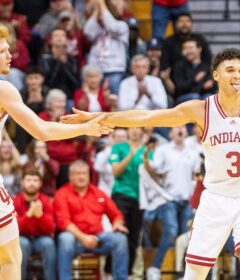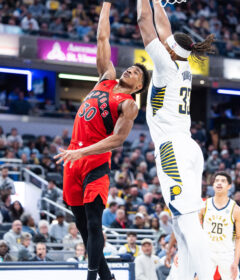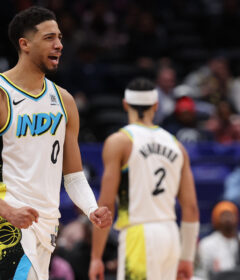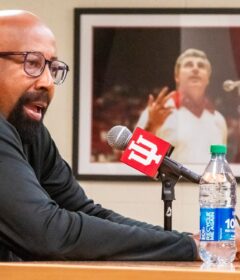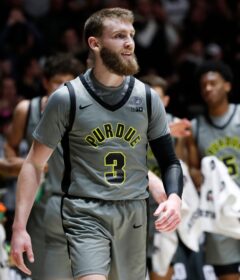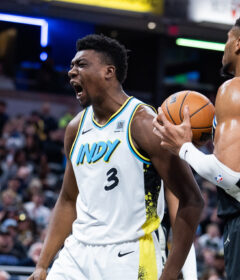Protecting large second-half leads at top of Indiana to-do list
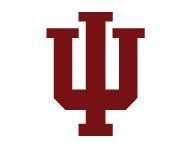
By CHRIS GOFF
ISL Correspondent
The Indiana Hoosiers left it all on the floor Thursday night.
Including, for example, two timeouts.
Indiana coach Tom Crean declined to call one with the game tied and his team in possession with 37 seconds left. But then Illinois’ John Groce made the same decision after the Hoosiers’ Victor Oladipo blocked D.J. Richardson’s last-second layup attempt, resulting in a rushed inbounds play that caught Indiana flat-footed, confused and then stunned. The Fighting Illini fought back for a 74-72 win.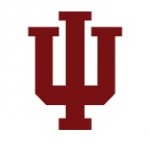
But let’s leave the timeout subplot alone and adjust the lens toward the bigger picture. One imagines the No. 1 team in the nation has much greater concerns stemming from Thursday’s game, considering it included a blown 14-point lead, 14 more turnovers, an ending fraught with defensive brain-lock and an alarming offensive tailspin in the final 10 minutes. The loss dropped Indiana to 20-3 and into a tie with Michigan and Michigan State for first place in the Big Ten.
Though it’s a puzzling premise to fathom given their amazing ability to open big leads in recent seasons, the Hoosiers’ big leads are exactly their problem right now.
For the first 35 minutes Thursday, Indiana did all the things we expect Indiana to do: play stifling defense, live up to its high standard on offense, control the boards and throw in the occasional razzle-dazzle from Yogi Ferrell or Will Sheehey.
That put Indiana up by 10 with 4:21 to go, but the Hoosiers melted down from there – most notably during Tyler Griffey’s wide-open cut to the basket with 0.9 seconds left. And it’s part of an unsettling trend in which the Hoosiers start fast but fade late.
Indiana scored 31 points after halftime Thursday, marking the sixth time in 10 conference games they were outscored in the second half. You can throw the 28-point second half against Georgetown into the mix, too, since the Hoyas’ seven-point comeback in the final 1:18 nearly stole the trophy at the Legends Classic. In each of those seven games, a second-half let-up from the Hoosiers either cost them the lead or tightened a previously one-sided game.
“It’s definitely a tough pill to swallow,” Christian Watford said. “You just have to learn from it. Losses like this you can’t do anything about. We know we let one get away from us.”
On a night ESPN voters dubbed him the nation’s best reserve, Sheehey was brilliant off the bench with 13 points, but like his teammates, did most of his damage in the first half. He scored 10, including 5-for-6 shooting, to give the Hoosiers a 12-point edge at the break. But he was 1-for-5 from the field in the second half, and had a key missed free throw late, on top of a 3-point miss that came just 12 seconds into the shot clock with Indiana leading by two.
You know what else would have helped the Hoosiers? Sheehey not getting a technical for taunting, which presented Illinois with two free points right when the Illini were in their most perilous state, down 14 with 90 seconds until intermission.
Ultimately, the one disappointment was how the Hoosiers gave the game away after they had it won.
“We didn’t put them away,” Crean said. “We had our opportunities. That’s really what the bottom line was. Our guys were prepared. They respect Illinois. We didn’t stay committed to what we wanted to do at the end of the game.”
And the question that arises is, Why? The coaches and players seemed to believe that the problems were mental and not – as some contend – varying levels of effort based on the scoreboard.
A sampling of opinions:
“When you’re going against great talent, which this league is full of, you’ve got to stay committed for 40 minutes,” Crean said. “You’ve got to keep your chest in front of the ball. You’ve got to keep your communication high. You’ve got to have that commitment to what makes you good.”
“We just have to do a better job of playing the full game,” said Jordan Hulls on Jan. 12, when Indiana let Minnesota trim a 23-point lead to three in the final minute. “We played real well in the first half, and then they came back. We have to do a lot better communicating on defense, pushing the ball more on offense, do what we did best at the end of the first half.”
“Shots just stopped falling,” said Cody Zeller after Indiana’s season-low 27-point second half in a Jan. 16 loss to Wisconsin. “Didn’t make enough shots. That’s all it boils down to.”
Perhaps this is just a temporary irritation that will all be forgotten when Indiana is cutting down the nets for a sixth time in early April. But while Watford tweeted that the Hoosiers simply need to learn from the collapse in Champaign, other measurements are suggesting a little more retooling.
For instance, Indiana only has the ninth-best turnover percentage in the conference, so you can’t just blame their big-lead issues on bad focus – and much of that 19.4 turnover rate was influenced downward during the Hoosiers’ easier 12-1 nonconference start. Since then they’re turning the ball over 20.5 percent of the time – good enough for many, but not for a Big Ten and national title hopeful.
The schedule has been tough, as it is for any Big Ten team this season, which is one reason the Hoosiers’ second-half problems have been more pronounced of late. However, it gets even more difficult the rest of the way. The Hoosiers still have road games left against Ohio State, Michigan State, Minnesota and Michigan, plus home dates against archrival Purdue and Ohio State.
“A league like this and you go out and find a way to win, that’s a big, big deal,” Crean said last month.
But this is Indiana. Since when was winning the only goal? This is the team that’s openly spoken of its championship ambition.
Because they have the confidence and talent, nobody is ready to doubt them just yet, certainly not over a slim February loss to 16-8 Illinois. But if the Hoosiers can’t figure out why their offense keeps suddenly stalling after halftime, or why large leads sometimes vanish as quickly as they arrive, then it might be the Hoosiers who abruptly disappear when the NCAA tournament starts six weeks from now.
Follow Chris Goff on Twitter: www.twitter.com/chrisgoff_isl
Follow Indy Sports Legends on Twitter: www.twitter.com/cliffbrunt_isl

